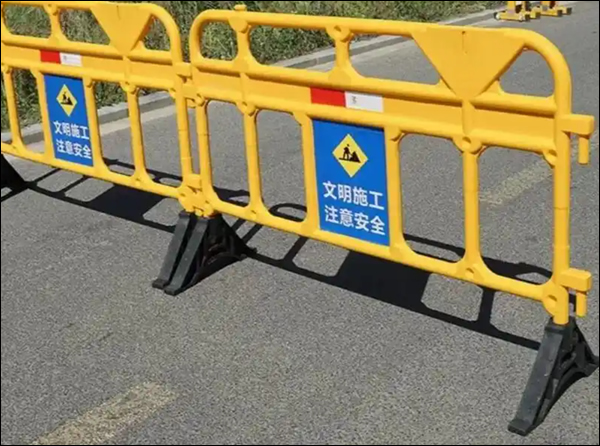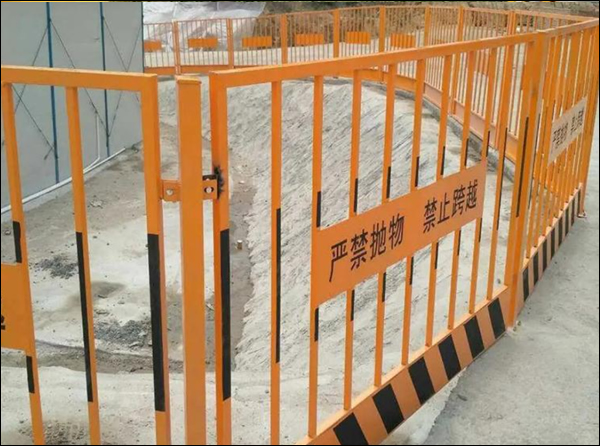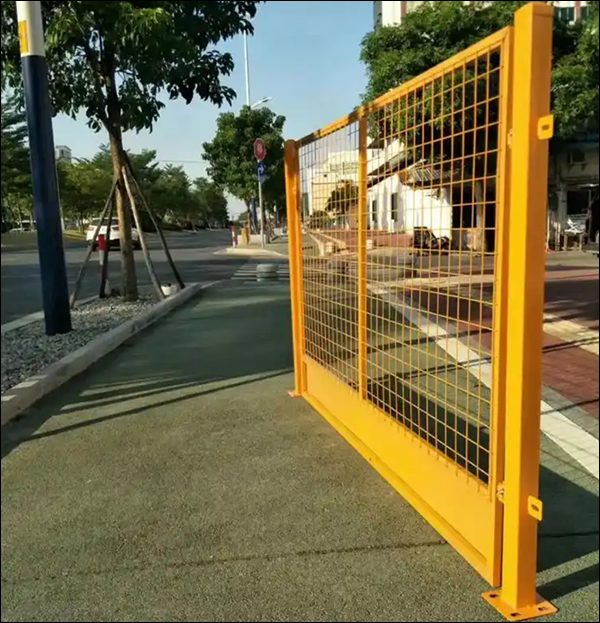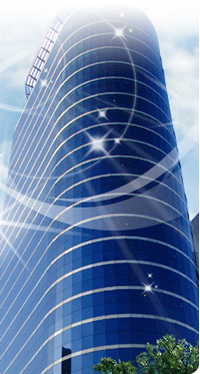
Traffic Control and Safety: Temporary Fencing for Road Construction
Temporary fencing is a versatile solution for managing site boundaries, controlling traffic (pedestrian and vehicular), enhancing safety, and securing work areas, especially in road construction. Unlike permanent fencing, temporary options are designed for easy installation, mobility, and adaptability to changing site conditions. Essential for road construction, temporary fencing provides safety, security, and effective traffic management. Understanding the various types, specifications, dimensions, installation, and accessories enables project managers to select the most appropriate solution.
Types of Temporary Fencing:
- Chain Link: A durable and secure option, typically made of woven steel wire mesh attached to metal posts.
- Panel Fencing: Prefabricated steel or aluminum panels for quick installation and a uniform look.
- Plastic Mesh Fencing: Lightweight for temporary demarcation and crowd control.
- Barricades: Traffic drums, cones, and portable barriers for channeling traffic and temporary closures.
Specifications:
- Temporary Fencing Dimensions
- Panel Width: Typically ranges from 3 to 8 feet (0.9 to 2.4 meters) per panel.
- Standard Heights:
- 4 feet (1.2 meters): Suitable for low-security areas and pedestrian control.
- 5-6 feet (1.5-1.8 meters): Common for general construction site fencing.
- 7 feet (2.1 meters) and above: Used for high-security areas requiring enhanced protection.
- Galvanized steel (corrosion-resistant) is common for chain link and panel fencing.
- High-density polyethylene (HDPE) is typical for plastic mesh.
- Mesh Size (Chain Link): Varies; smaller mesh provides greater security.
- Post Spacing: Affects fence stability; closer spacing is needed for higher fences or windy areas.
- Wire Gauge (Chain Link): The gauge refers to the thickness of the wire. A lower gauge number indicates a thicker wire. Common gauges for temporary fencing might be 9 GA (3.67 mm), 11 GA (3.05 mm), or 12.5 GA (2.41 mm). The appropriate gauge depends on the desired level of security and durability.
Dimensions:
- Panel Width (Panel Fencing): Standard widths include 6 feet (1800 mm), 8 feet (2400 mm), 10 feet (3000 mm), and 12 feet (3600 mm).
- Roll Length (Chain Link): Typically sold in rolls of 50 feet (15 m).
Installation:
- Post Driving: Posts are driven into the ground (typically for chain link).
- Panel Connection: Panels are connected using clamps or brackets.
- Base Plates: Used on paved surfaces to support posts.
- Bracing: Diagonal bracing provides additional stability.
Accessories:
- Gates: Swing or sliding gates for access.
- Barb Wire: Added to the top of the fence for increased security.
- Windscreens: Fabric screens to reduce wind resistance and provide privacy or dust control.
- Signage: Signs attached for warnings or information.
- Lighting: Added for nighttime visibility.

The barriers are bright yellow, made of molded plastic (likely high-density polyethylene or HDPE), and feature a rectangular frame with vertical and horizontal bars creating a grid-like pattern. This design provides visibility while also preventing easy passage. The barriers have interlocking mechanisms on their ends, allowing them to be connected to form continuous lines or enclosures. Each section has black plastic feet that provide stability on various surfaces. There are blue and white signs attached to the barriers with Chinese characters. The top of the barrier has a smooth, rounded handle for easy carrying and placement.
- Height: 1 meter (3.3 feet) tall from the ground to the top of the handle.
- Length (per section): 2 meters (6.6 feet) long.
- Width (thickness): 5-10 cm (2-4 inches) thick for the frame.
- Footprint (base): Each foot likely extends about 40-50 cm (16-20 inches) outward from the barrier on each side for stability.
- Weight (per section): Likely between 10-15 kg (22-33 pounds) due to being made of plastic, making them relatively easy to move and position.
- Material: High-density polyethylene (HDPE) plastic.
- Color: Primarily yellow with black bases.
- Signage: The attached signs appear to 30-40cm (12-16 inches) wide and 20-30cm (8-12 inches) tall.
Key Features
- Interlocking Design: Allows for easy connection and configuration.
- High Visibility: The bright yellow color ensures good visibility, even in low-light conditions.
- Lightweight and Portable: Easy to move, transport, and set up.
- Durable and Weather-Resistant: HDPE plastic is resistant to impacts, weather, and UV degradation.
- Stable Base: The wide feet provide stability on various surfaces.
These types of barriers are a common sight at construction sites and other areas requiring temporary demarcation or traffic control.

Temporary crowd control, construction site demarcation, or traffic management.
Temporary crowd control barriers are primarily orange, with some black and white striped sections at the base. They consist of vertical bars welded to horizontal top and bottom rails, creating a fence-like structure. Some sections have a solid panel attached for signage. The barriers are connected end-to-end, forming a continuous line.
- Height: 1 meter (3.3 feet) to the top rail.
- Length (per section): 2-2.5 meters (6.6-8.2 feet).
- Width (thickness of frame): 5-7 cm (2-2.75 inches).
- Vertical Bar Spacing: Roughly 10-15 cm (4-6 inches) between bars.
- Base/Foot: simple flat bar or small feet extending outward for stability. around 30-40cm (12-16 inches) wide.
- Material: Painted steel (mild steel).
- Color: Primarily orange with black and white striped sections.
- Signage: The attached sign is rectangular and 50-70cm (20-27 inches) long and 20-30cm (8-12 inches) high.
Key Features
- Simple and Sturdy Construction: Provides a basic level of physical barrier.
- High Visibility: The orange color makes them easily noticeable.
- Connectable Design: Allows for flexible configuration and extension of the barrier.
- Durable Material: Steel construction provides good resistance to impacts and weather.
Uses
- Construction site perimeters
- Crowd control at events
- Temporary traffic management
- Pedestrian walkways

Construction Site Temporary Fence Panel
This is a prefabricated temporary fence panel made of welded steel wire mesh within a steel frame. The entire structure is painted bright yellow for high visibility. The mesh provides a visual barrier while allowing for airflow and some visibility through it. The panel has flat feet with pre-drilled holes, anchoring to the ground or other surfaces. The design suggests a focus on security, durability, and ease of deployment.
- Height: 2 meters (6.6 feet).
- Width: 2.5-3 meters (8.2-9.8 feet).
- Frame Thickness: 5-7 cm (2-2.75 inches).
- Mesh Size: The openings in the mesh 10-15 cm (4-6 inches) square.
- Wire Diameter: The wire used for the mesh 3-5 mm (10-14 gauge).
- Base/Foot Dimensions: The feet 30-40 cm (12-16 inches) long and 10-15 cm (4-6 inches) wide.
- Material: Painted steel ( mild steel).
- Color: Bright yellow.
Key Features
- Welded Wire Mesh Infill: Provides security and visibility.
- Sturdy Steel Frame: Offers structural integrity and durability.
- High Visibility: The yellow paint enhances visibility.
- Pre-Drilled Feet: Facilitates anchoring for added stability.
- Portable and Reusable: Designed for easy transport and repeated use.
Uses
- Construction site perimeters
- Security fencing for events
- Temporary barriers for public works projects
- Crowd control
